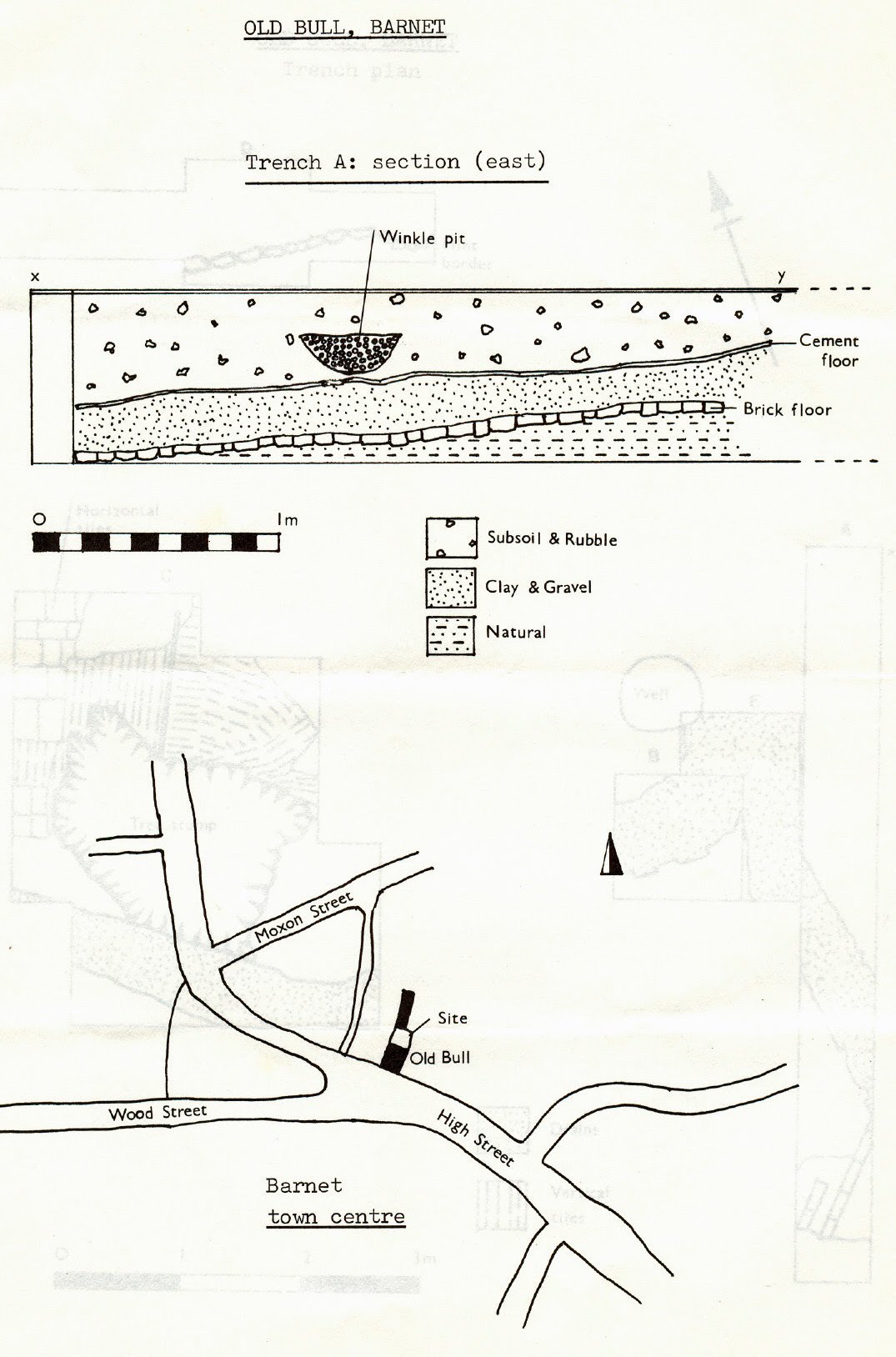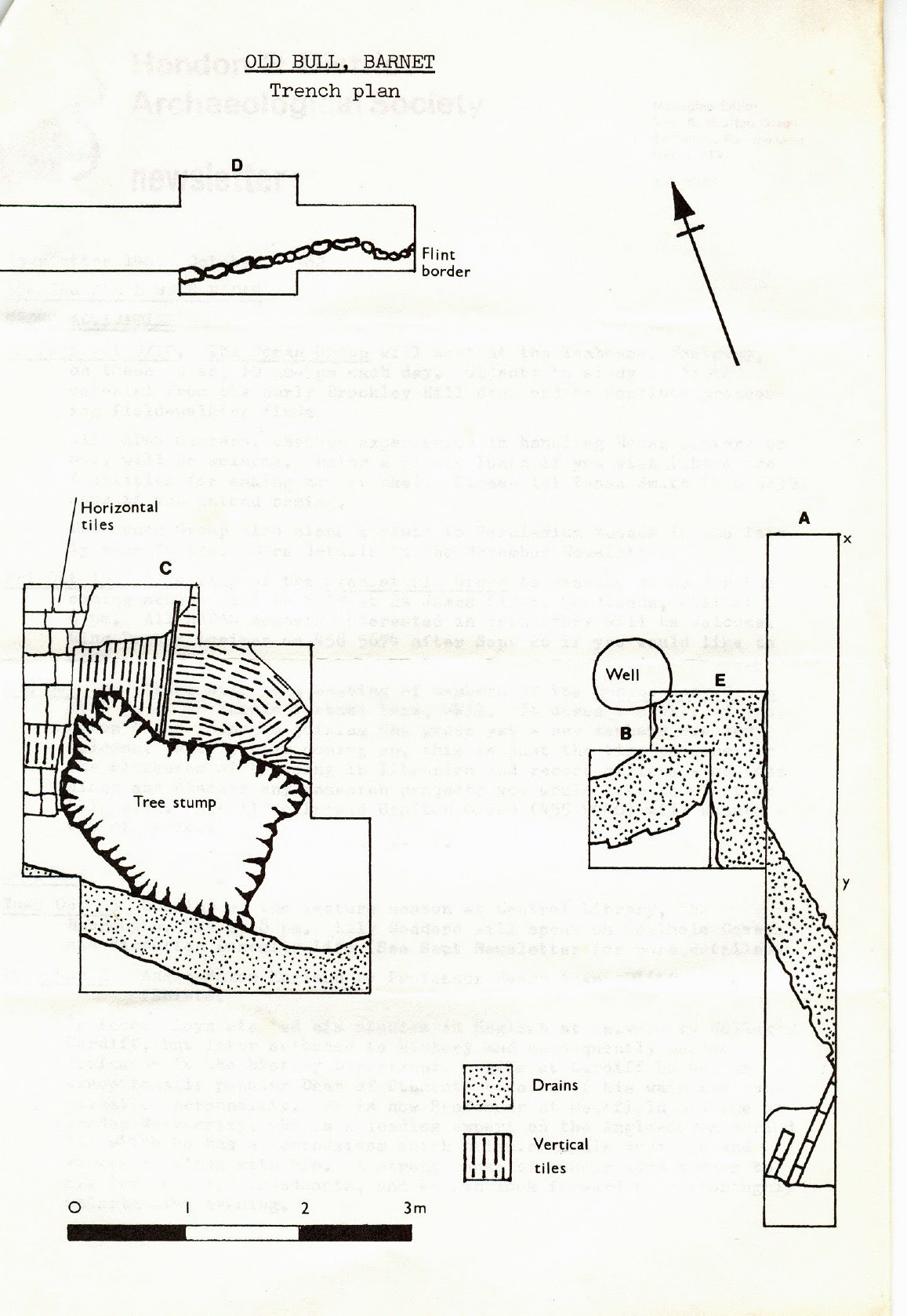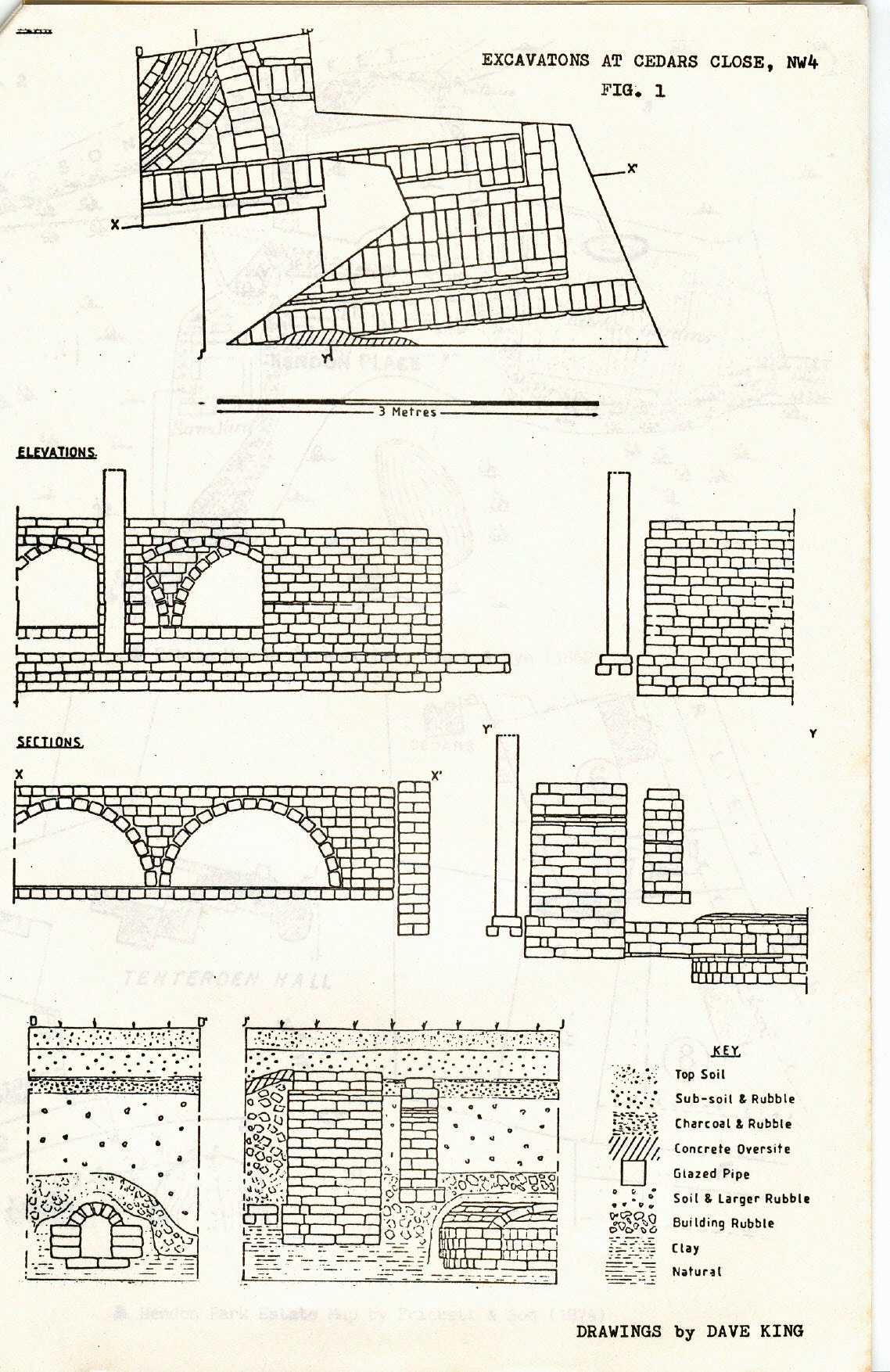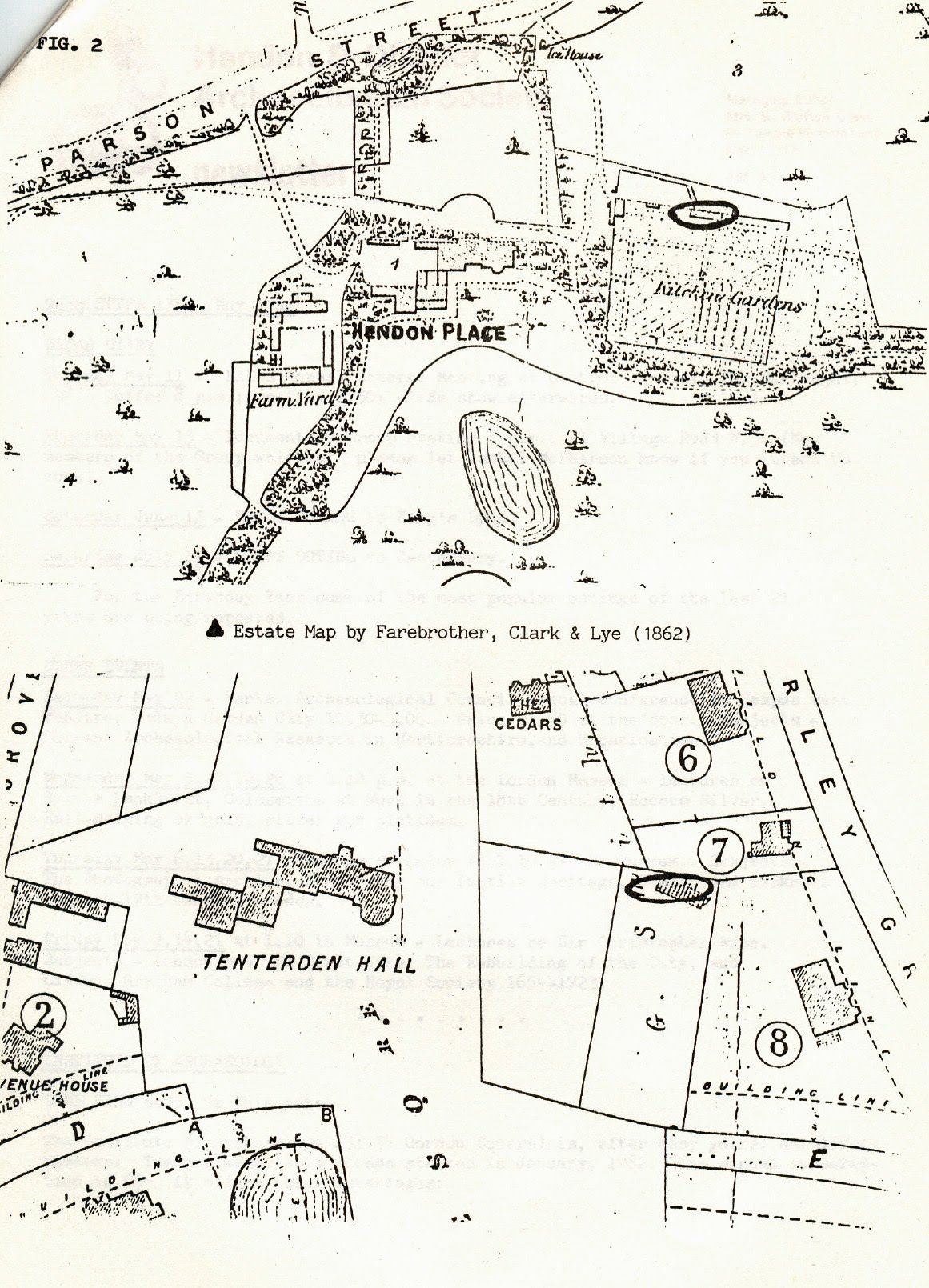Newsletter No.142: December 1982
GREETINGS AND BEST WISHES
TO ALL MEMBERS FOR A VERY
HAPPY CHRISTMAS
PROGRAMME NEWS
Monday December 13th 1982. Christmas Supper Party at Burgh House. This has proved enormously popular, with regrettably over 20 disappointed members. If anyone who has booked finds they cannot attend please let Dorothy Newbury know (203 0950) so that someone else can attend.
Tuesday January 4th 1983. Marylebone Park 1537-1811, by Dr. Anne Saunders who is making a return visit to us to talk on her favourite subject.
Tuesday February 1st 1983. Origins and development of the Safety Pin, by Dr. John Alexander.
Tuesday March lst 1983. Egypt, Gift of the Nile, by Vivienne Constantinides.
Tuesday April 12th 1983. Early Mining and Metallurgy from its inception to the Bronze Age, by Paul Craddock.
OBITUARY
This is very sad paragraph to write. One. of our members of very long standing, Harry Lawrence, died on November 11. Most people in HADAS will remember Harry with affection and pleasure even though, because of uncertain health, he has been unable for the last few years to join us in the lectures and outings which he enjoyed so much.
Harry was a “doer”, not an onlooker; he liked to be involved in the Society’s activities as much as possible. When he went on outings and this despite increasing breathlessness – he was one of those who always climbed to the top of the mound or negotiated the depths of the cave.
For a long period in the ’70s he addressed, in his clear, sloping hand, all the Newsletter envelopes. The weight of this job became steadily heavier as the Society expanded. In February 1977 we bought an addressing machine to save Harry having perpetual writer’s cramp; but for some time longer he “stuffed”, stamped and posted the Newsletter, until Irene Frauchiger nobly took over from him.
He will be greatly missed by all his friends; and we send our deep sympathy to his wife, Vivien, also a member of HADAS until recently.
ADVANCE NOTICE
VISIT TO SOUTH WEST WALES
A 5 day trip to South West Wales is proposed for August 31st – September 4th 1983, staying at the Dale Port field centre (in a Victorian Port) in the most south westerly parish on the Pembrokeshire coast. The area is rich in Bronze Age stone monuments and Iron Age fortified settlements, and it is hoped that Professor Grimes will be our guide on one of the days. Roman sites, Norman castles and many other places are other possible parts of the itinerary.
The field centre needs to be booked now, so we need an indication of the number of people interested in the trip. It is hoped to keep the cost below £80. Please telephone Pete Griffiths (61-23156) to let him know if you are interested.
PREHISTORIC GROUP by Daphne Lorimer
WATER WALK
The first of a series of field walks to examine the Silk Stream and its environs was undertaken on November 14. Heavy rain cut the meeting short but – a stretch of the stream in Montrose Park, from the pavilion to the bridge over Montrose Avenue, was inspected.
The stream was fast-flowing and meandered between partially constrained banks forming narrow beaches at the curves where gravel and debris collected. A quantity of fine was retrieved, ranging from 19C pottery to butchered animal bones (including a bovine scapula) and the handles of two saws. These beaches will bear watching after heavy rain, provided the river has not risen too high.
The walk will continue on Sunday December 12, under the leadership of Sheila Woodward. The meeting place is still the gates of Montrose Park, at l0 a.m. would those intending to come please ring-Jenny Griffiths (612.3156).to say so (just so that no-onegets left behind.)
There will also be a river walk on Boxing. Day morning (very good for removing traces off Christmas excesses). This will be led by Daphne Lorimer and it would be helpful if you could let her know (after December.16,.on 458.5674) if you are going to join it. The walk will start at 10 a.m. but the precise rendezvous will be decided only after the walk on December 12 – Daphne will be able to tell you when you telephone her.
The water walk provided one of those classic moments which sometimes happen. at HADAS events. None of us will forget the sight of .a HADAS Committee member striding down the Silk Stream, the water surging half way up her wellies, while above her head she carefully held an umbrella!
CORRECTION
The Newsletter’s right hand obviously didn’t know what its left hand was doing last month: because, in describing how to get to the new premises of the Greater London Record Office, we carefully told you to walk along Farringdon Road in the King’s Cross direction and “turn left into Bowling Green Lane.” We should, of course, have said “turn right.”
As the new Record Office doesn’t open till January 4 next, we hope this correction will come in time to prevent you getting lost in what has been described as “a most bewildering hinterland.” Many thanks to keen-eyed HADAS member Linda Webb, who spotted the mistake and rang us at once. “I used to live in those parts,” she said, “and it’s dead easy to get lost:”
ANGLO-SAXON ENGLAND Report on the November lecture by Audrey Hooson
At the start of his lecture, Prof. Loyn referred to the memorial service which he had attended the previous Saturday for Prof. Dorothy Whitelock, one of the greatest,Anglo-Saxon scholars of this century. The occasion prompted him to give us not the expected illustrated lecture on Anglo-Saxon archaeology with reference to his own speciality of coinage but a more challenging one, introducing some recent themes in hostorical discussion and the ways in which attitudes and emphasis now differ from those in the past.
. . .
It is now considered that the flow of the conversion of the Pagan Anglo-Saxons to Christianity was both gradual and complex with the Celtic Custom coming from the North and West and the Roman brought by St.Augustine in 597 The main source for this period is Bede’s History of the English Church and People which was completed in 731. Prof. Loyn quoted from Book 3, Chapter 25, which describes the Synod of Whitby when the two Churches were brought together by Oswy, King of the Northumbrians.
From 800 to almost the Anglo-Saxons were fighting against the Danes to keep their country. The first Viking Age, from 800-950, was probably a • period of colonization by settlers looking for new land. This gave rise to the Danelaw with the division of the country by King Alfred in 880 utilising the River Lea and Watling Street. The second Viking Age was a National movement emanating from Scandinavia. While there has been little archaeological evidence in the past to confirm this, recent excavations at York and Lincoln, combined with numismatic, linguistic and place name evidence indicate that great parts of the country were overcome and transformed. In addition to the Fortified Market Towns founded by the Vikings, the. Burghs planned by Alfred to protect and consolidate Wessex were also part of an Urban revival in the late 10th and early 11th centuries.
During the 10th century, the Benedictines were firmly established in England: It is possible that their secular influence has been underestimated. When England was united under Edgar, the Benedictines were probably responsible for the development of ordered government and the legal system. They also helped to mould the English language into a scholarly instrument„
The Benedictine revival was part of a European movement. One of the most exciting reassessments in recent years, partly based on. Martin Biddles’s Winchester excavations, has been the recognition of a breakthrough in architectural and sculptural development around 1050. The Norman Romanesque, previously considered to have been only introduced to England after 1066, is now thought to be a continuation of these Anglo-Norman developments. Prof.Loyn felt that there is still much that might be discovered by further excavations on both sides of the Channel and examination of buildings in the Duchy of Rouen. Unfortunately, there was not enough time for him to elaborate on this his final theme of a very interesting, informative and stimulating evening.
PHOTOGRAPHIC DISPLAY by Ted Sammes
The November lecture was made doubly memorable by Ted’s collection of photographs mounted on screens showing the Society’s history throughout its 21 years. We owe him a vote of thanks for taking so much trouble and look forward to seeing them again at Burgh House at the Christmas Supper.
A SYMPOSIUM ON EARLY FURNACE TECHNOLOGY Report by Alec Gouldsmith
This was arranged by the Historical Metallurgy Society and the British Museum Research Laboratory and held in the main lecture theatre of the British Museum on 29-30 October 1982.
Twenty-six papers were presented covering remains and discoveries from the inception of smelting to the end of the medieval period, in areas ranging from Western Europe (Spain and Britain) to the Indus Valley and from the State of Niger Nest Africa) to Central Sweden. The metals mainly discussed were naturally copper and iron, tut papers on silver, gold, zinc and lead were included.. Although the 130 registrants present came mostly from Europe, Western Asia, India and America were also represented. The proceedings will be published shortly as a British Museum Occasional Paper.
Organisation was handled by the B.M. Research Laboratory – Dr. Paul Craddock, a HADAS member playing a most prominent part. His wife, Brenda, also well known to HADAS members, provided an excellent lunch each day in the Sloane Room where the newly acquired portrait of Sir William Hamilton gazed down on us.
DOCUMENTARY GROUP
Wanted: a volunteer – or perhaps two – to undertake a project which is part fieldwork, part documentary research.
The Documentary Group has been asked to investigate how many flint-built buildings (especially public buildings, but dwelling houses could be included) there are in the Borough of Barnet, when they were built and where the flint to build them came from. Several in the north part of the Borough spring to mind Pagitt’s Almshouses in Hadley present buildings 1822 and 1849.
This is research which could be done in your own time: there is no deadline on it. The end-product will be, it is hoped, a ‘report for publication in the. Newsletter. If you are interested, please give Brigid Grafton Green a ring on 455 9040: she’ll be delighted to hear from you.
POPULAR ARCHAEOLOGY
Popular Archaeology the monthly journal edited by Professor Barri Jones of Manchester University, has recently begun a circulation drive, which HADAS is happy to help.
The magazine gives a good coverage of both professional and amateur archaeology in Britain; it is aimed at the general reader, rather than the expert. Dr. David Trump of Cambridge University.(who many HADAS members will know) writes “I wouldn’t be without Popular Archaeology, and I warmly recommend it to anyone who wishes to learn more of the wide scope, significance and sheer thrill of archaeology.”
If you would like to subscribe to the magazine – which costs 95p a month – write to Popular Archaeology, Free Post, 24 Barton Street, Bath; BA1 1FH for -further details.
FIELD NAMES AND STREET NAMES by Nell Penny
I presume developers and builders have always had the right to name roads they create – or they have taken the right. The noble Russell family spread themselves and their estates all over their Bloomsbury development. Russell and Bedford Squares and Woburn and Tavistock Places are a few of the names om- humble builder in Kentish Town celebrated the Crimean War, 1854-56, with Inkerman Rd., Alma St. and Raglan St. I wonder if there is a builder waiting to name Falklands Way and San Carlos Crescent when the economic climate warms up..
Some C19 and C20 builders in Hendon seem to have taken their inspiration from the commutation of Church Tithes from kind to money. Or was local oral tradition strong enough for the builders to have been told the names of the fields they had bought? Here are some of the street names which have been derived from field or estate names.
Hodford Road NW11 can be traced back to Hodford Wood fields which were near the Hampstead border of Hendon and as far back as 1321 when Sir Henry Scrope held the “manerium de Hodeford”.
Significantly in Mill Hill NW7 there is Longfield Av. and Tithe Walk. I do not think that it matters that they are on the wrong side of Page St. Nearer and further LongfeIds were on the other side, in the angle of Page St. and Wise Lane. In 1635 they were “a croft called Longfield at.Featherstowe Hill.”In Hampstead Garden Suburb Asmuns Hill and Place may be traced through First-and Middle Assmans Fields to Manasses Burripa, manor tenant in 1685, and Willifield Way comes from Willeyford Grove Field. Blessbury Road along the former boundary with Edgware goes back to a field Blessebe Hale in 1685.
Deerfield Cottages NW9.is on the east side of the “West Highwaye” at the Hale. It has a long pedigree – mentioned in 1321 and mapped as the property of All Saints’ College Oxford in 1590.
Downage NW4 reminds one that there were five Downage fields carved out of woodland by 1754,Thistly Downage, Little Downage Wood Field, Upper and Lower Downage and Eight acre Downage Wood. I think these fields relate to the “wood called the Donehedge” in the Black Survey of 1321.
In a C17 survey Fryers Lande is referred to – in 1754 and 1842 there were Fryant Grove Fields and today there are Fryent Crescent and Fryent Grove in NW9.
Near the Edgware boundary there were fields Hither and Further Oldberries in 1574 and today there is Oldberry Road..
Sheareshill Av. NW9 refers to the only documented “open field” in Hendon, not mentioned in 1321, but continuously recorded between 1574 and 1860.
Sunningfields Rd.NW4 is taken from the two SunnyHill Fields. Two other names show where builders were not concerned with strict accuracy in their names. Sherrock Gardens NW4 is downhill from the Middlesex Poly on Greyhound Hill, but four sizeable Sherrock Fields were between Church End and Parson St. Thornfield Av. NW7 is on the south side of Holders Hill Rd., but two Thorn Fields were on the north side of the roads. Builders seem to have chosen innocuous field names.. Nobody wanted Bottom Field, Hungerlands or Mucknell for their beautiful new roads.
SAFFRON FIELDS
There were two Saffron Fields in Hendon. Usually this name indicates that saffron was originally grown there, although we have no other evidence of its cultivation in Hendon.
One Saffron Field was in Mill Hill, on the west side of Hammers Lane. It was surveyed in 1754 and in 1842 and was about 6½ acres. A reference in the 1685 survey to a Saffron Field 5 acres, may relate to this field. The other Saffron Field was in Temple Fortune, on the south side of Bridge Lane. This was also surveyed in 1754 and 1842 and measured about 10 acres.
Field’s Dictionary of English Field names refers to the saffron crocus (crocus sativus) introduced into England about 1340. The herb was extensively grown in late medieval times in Essex where, according to Ekwall, it gave its name tope Saffron. Walden (“Waledana” in Domesday Book, but “Safforne-walden” by 1582). Saffron is the dried, orange-coloured stigmas of the saffron (or autumn) crocus. To medieval cooks it was the most important – because the-most -costly of all herbs. Originally from the east – Persia and Arabia – it had been acclimatised in Spain by the 10th C, and figured prominently in the 13C trade between. Spain and England. It takes about 75,000 flowers to make 1 lb. of saffron, and in 1265 it cost Eleanor de Montfort, Countess of Leicester, between 10s-14s (50p-70p) per lb. (See Manners & Household Expenses in 13c-15c, ed. H.T.Turner, Roxburghe Club, 1841). Eleanor never bought more than a lb. at a time. It was a popular ingredient in many medieval sauce recipes and even had its own terminology. The medieval cook spoke of “garnishing” a dish with parsley, but he “fringed” it with saffron.
Dr. Tobias Venner, a doctor of physic who lived in Bath and wrote a very early book on dietetics called Via Recta Ad Vitam Longam in 1637, had this to say on the attributes of saffron: “The moderate use of it wonderfully refresheth, comforteth, strengtheneth and exhilarateth the heart for there is so great society betwixt it and the heart that it is without delay carried thither … ”
The saffron grown in East Anglia was used mainly for the English food market, both for colouring and flavouring food; but it was also used for dyeing cloth. It produced a russet shade, for which the cloth makers of Colchester were well known in medieval times.
And we can take it back much further than that, for saffron was a herb well known to the Romans, and Apicius, in the first part of 1st C AD, includes 3 scruples of saffron in his recipe for Roman vermouth; and gives this recipe for “Aromatic Salts to be used for many things:”
“Aromatic salts are for the digestion, and to move the bowels. They prevent all diseases and the plague, and all colds. Moreover, they are mild, beyond all expectation.
Take 1 lb. dried common salt, 2 lb. dried. sal ammoniac, 3 oz. white pepper, 2 oz. ginger, 1 oz. cumin, oz. thyme, 1½ oz. celery- seed (if you do not want to take celery seed, take 3 oz parsley instead),3 oz origano 1½ oz rocket-seed, 3 oz black pepper, 1 oz saffron, 2 oz hyssop from Crete, 2 oz aromatic leaves (these can vary; bay leaf is usually used today), 2 oz dill.”
Nowadays saffron is best bought at a good herb shop, either in slim strands or powdered (the strands have most flavour). Infuse them in a little warm milk and water for 15 minutes, and use the infusion.
BOOK REVIEWS by Raymond Lowe
Recording A Church: an illustrated-glossary by Thomas Cooke, Donald Findlay, Richard Halsey and Elizabeth: Williamson. Drawings by George Wilson
Council for British Archaeology, 1982, £1.50
Each of the four authors of this 48-page booklet works for an organisation concerned with the architectural history of churches: that is, respectively for the Penguin Buildings of England series, the Council for the Care of Churches, the department of the Environment and the Royal Commission on Historical Monuments (Eng). They are described-as “spending much of their working lives writing descriptions of churches.”
One day they got together and decided to standardise their use of architectural terms; and, after working on this idea for a while, they realised that the final glossary might well be of interest to people outside their own immediate circle. This booklet is the result. It is concerned particularly with finding the right names and descriptions for everything architectural (i.e. not moveable fittings, like chairs) in a typical parish church. It will be valuable to anyone writing a parish history or even preparing a report for the Newsletter on a HADAS visit to a church. Not only does it provide the correct word: in many cases it illustrates the object as well, and does so in simple, lucid drawings which show, for example. 11 types of arches found in churches; 6 types of capitals; gables; fonts; mouldings; vaults; traceries; and so on.
Romano-British Mosaics by Peter Johnson Shire Archaeology, £1.95
Some subjects are ideally suited to the Shire Archaeology format and mosaics are just such a subject.
Few archaeological remains capture the imagination of the ordinary man more than Roman mosaics; and there is nothing in the corpus of archaeological writing to compare with this little book. Every important mosaic) site should have a stock to sell to the public,
Mr. Johnson sets out his subject in clear logical divisions, starting with design, construction and materials. The next. four chapters take a century at a time and deal with the sites, types and schools (or officinae). The developments, evolution and devolution is clearly shown. The 44 illustrations are very well produced; and there are three distribution maps for the officinae. The book is up-to-date. The front cover shows the Orpheus pavement at Littlecote (how about that as the venue for a HADAS outing?); and there is a drawing of the newly discovered lst C. pavement at Fishbourne. The book finishes with a list of sites, and a glossary. For those who are keen there are also some non-British mosaics in the Victoria and Albert Museum. One small oversight: Mr. Johnson states that mosaics moved on to the walls of Byzantine churches in late antiquity. Anyone who has visited Pompeii and Herculaneum will remember the mural mosaics there, at AD 79.
If you are interested in things Roman do get a copy from Jeremy Clynes (66 Hampstead Way, NW11. 455 4271). Should you find you would like to continue the study, there is now a special society which publishes a twice-yearly journal: the Association for the Study and Preservation of Roman Mosaics. For further information about it, apply to Peter Johnson, Littlecote Park, Chilton Foliat, Hungerford, Berks.RG17 4SU.
R.T.Lowe
Also available from Jeremy Clynes is another newly-published Shire Archaeology volume: Roman Crafts and Industries, by Alan McWhirr, who has been directing excavations at Cirencester (Roman Corinium) and who specialises in the study of Roman brick and tile. This book also costs £1.95 (if ordering either, please add 20p for post and packing).
MORE ABOUT MOSAICS
Corinium Museum at Cirencester reports that the Venus mosaic from Kingscote is now on display, after 2 years’ work and a public appeal which raised £5,000.
The mosaic, from a Roman-British site in the west Cotswolds, near Tetbury, is the first part of a display which will highlight life in the countryside of Roman Britain Material from two nearby sites – Claydon Pike and Barnsley Park will also be used in the final exhibition.
TWO INTERESTING EVENTS
At CHURCH FARM MUSEUM from Nov.20-Jan 16 there is an exhibition mounted by the Hendon & Hampstead Antique Ceramic and Glass Club of 19th century British pottery and porcelain with special emphasis on Wedgwood, Royal Worcester, Minton, Spode and Staffordshire blue-and-white ware.
CBA 7 February CONFERENCE at Campus West, Welwyn Garden City, Herts. Subject “The End of Roman Britain”. Details from Ted Heathman, 92 Charmouth Rd., St.Albans (Tel. 58136)





